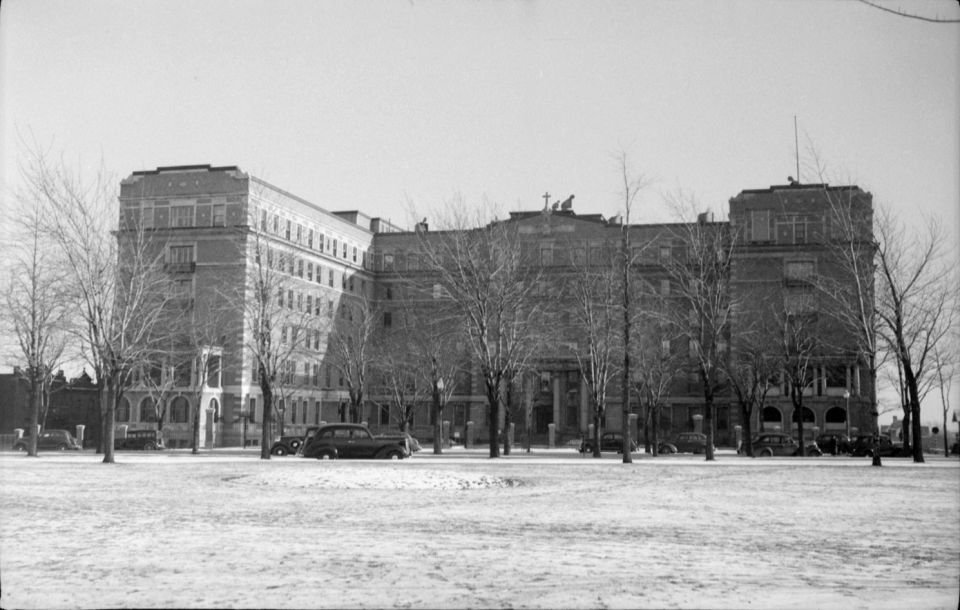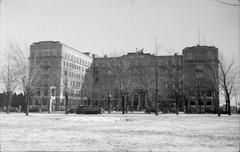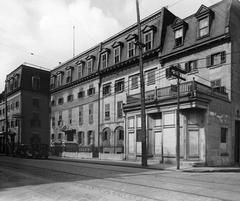
Hôpital Notre-Dame Montreal: Visiting Hours, Tickets, and Historical Information
Date: 14/06/2025
Introduction
Hôpital Notre-Dame in Montreal is a storied institution that has played a vital role in Quebec’s healthcare evolution since its founding in 1880 by the Sisters of Charity of Montreal, known as the Grey Nuns. Originally established to meet the needs of a rapidly growing and diverse population, the hospital has grown from a modest charitable facility to a cornerstone of the province’s modern healthcare system. Today, it forms part of the Centre hospitalier de l’Université de Montréal (CHUM) network, continuing to blend historical significance with state-of-the-art medical care.
This comprehensive guide covers everything visitors and history enthusiasts need to know: visiting hours, admission policies, accessibility, guided tours, and the hospital’s unique legacy. You’ll also find practical travel tips and nearby attractions to enrich your visit. For the most current visitor information and events, refer to the official CHUM website and CIUSSS Centre-Sud-de-l’Île-de-Montréal.
Table of Contents
- Historical Overview
- Visiting Hôpital Notre-Dame
- Visitor Experience & Tips
- Visuals and Media
- Frequently Asked Questions (FAQ)
- References and External Links
- Conclusion & Call to Action
Historical Overview
Founding and Early Development
Founded in 1880 by the Grey Nuns, Hôpital Notre-Dame was created to serve Montreal’s expanding working-class neighborhoods. Its mission was rooted in Catholic charity, focusing on providing quality care to the city’s underserved. By the early 20th century, the hospital had expanded its facilities and staff, reflecting Montreal’s burgeoning population and evolving medical needs. In 1924, the hospital established an affiliation with Université de Montréal, solidifying its role as a leader in medical education and research (Wikipedia: Hôpital Notre-Dame).
Architectural Evolution
The original hospital building, located on rue Saint-Denis, was designed in a functional late 19th-century style. Throughout the 20th century, the hospital underwent significant expansion, incorporating Art Deco and modernist architectural elements. The 1924 relocation to Sherbrooke Street East allowed the institution to grow from a 25-bed facility to a modern hospital with hundreds of beds and specialized departments, including research laboratories and teaching facilities (CIUSSS Centre-Sud-de-l’Île-de-Montréal).
The 1934 “Days of Shame”
A pivotal event in the hospital’s history, the 1934 “Days of Shame,” occurred when staff staged a four-day strike in protest of Dr. Samuel Rabinovitch’s appointment—the first Jewish senior intern in a French Canadian hospital (Wikipedia: Days of Shame). The strike, rooted in antisemitism, led to Dr. Rabinovitch’s resignation and exposed systemic prejudice, prompting the establishment of the Jewish General Hospital. This episode is a landmark in Montreal’s struggle for diversity and inclusion in healthcare.
Role in Medical Education and Research
Since the 1920s, Hôpital Notre-Dame has served as a crucial training site for medical students, residents, and fellows from Université de Montréal. The hospital’s robust education and research programs have contributed significantly to Quebec’s advancements in cardiology, oncology, infectious diseases, and surgical innovation (Wikipedia: Hôpital Notre-Dame).
Community and Social Role
Centrally located in Montreal, Hôpital Notre-Dame has long served diverse populations—including immigrants, the working poor, and marginalized groups. The hospital played instrumental roles during public health crises such as the polio and HIV/AIDS epidemics. Its emergency and specialized clinics continue to provide critical care to the community (CIUSSS Centre-Sud-de-l’Île-de-Montréal).
Modernization and CHUM Integration
Recent decades have seen Hôpital Notre-Dame modernize with cutting-edge equipment, electronic records, and patient-centered models. In 2017, it became part of the CHUM network, streamlining services and expanding research and training opportunities (Wikipedia: Hôpital Notre-Dame). The hospital now provides a wide spectrum of medical and surgical services.
Notable Figures
- Dr. Emmanuel Persillier-Lachapelle: Founder and key medical leader.
- Sister Élodie Mailloux: Founder of the first French Canadian nursing school in 1898.
- Dr. Samuel Rabinovitch: Central figure in the 1934 “Days of Shame.”
- Mother Julie Haineault-Deschamps and Sulpician Benjamin-Victor Rousselot: Pioneers in the hospital’s early history.
Heritage Status
The hospital’s Sherbrooke Street building is classified as a heritage property of exceptional value by the City of Montreal (fr.wikipedia.org). Efforts continue to preserve its historic architecture and archives, documenting its evolution and societal impact.
Legacy in Montreal
Hôpital Notre-Dame’s legacy lies in its ongoing service to Montreal and its influence on healthcare, diversity, and social responsibility. It remains a vital community hospital and a living testament to Quebec’s medical history.
Visiting Hôpital Notre-Dame
Visiting Hours
- Patient Visits: Generally from 10:00 AM to 8:00 PM daily.
- Departmental Variations: Some areas may have different hours. Always confirm on the official website or by calling ahead.
- Public Health Restrictions: Hours may change during flu season or public health emergencies.
Admission Policies and Tickets
- General Admission: No fee or ticket required for patient visits.
- Historical Tours: Guided tours may be available during heritage events or by request; check with local heritage organizations or Montreal’s cultural programs.
Accessibility
- Location: 1560 Sherbrooke St E, Montreal, QC H2L 4M1.
- Transport: Served by STM bus routes and Sherbrooke metro station; on-site parking is available for a fee.
- Facilities: Fully wheelchair accessible; bilingual staff; translation services available.
Guided Tours and Special Events
- Tours highlighting the hospital’s architecture and history are occasionally offered during Montreal Heritage Days or university open houses.
- For schedules and booking, consult the CHUM website or the Montréal Tourist Information Office.
Nearby Attractions
- La Fontaine Park: Directly across Sherbrooke Street.
- Plateau Mont-Royal & Quartier Latin: Nearby vibrant neighborhoods.
- Old Montreal & Notre-Dame Basilica: A short transit ride away.
- Pointe-à-Callière Museum & Montreal Science Centre: Accessible for those interested in city history and science (Quebec Wonders).
Visitor Experience & Tips
- Arrive Early: For appointments or administrative matters, early arrival can help avoid crowds.
- Bring Documentation: Health insurance cards (RAMQ for Quebec residents), identification, and a list of medications.
- Expect Waits: Emergency department wait times can be long; minor issues may be better handled at clinics.
- Language: French is the primary language, but English-speaking staff are present; translation services are available.
- Parking: Limited and paid; public transit is recommended during peak hours.
- Safety: The hospital and surrounding area are generally safe; standard urban precautions apply (Lonely Planet).
Visuals and Media
- High-quality images of the hospital’s façade, interior, and archival artifacts are available through the CHUM website.
- Virtual tours and maps offer remote access to the hospital’s heritage features.
Frequently Asked Questions (FAQ)
Q: What are the hospital’s visiting hours?
A: Typically 10:00 AM to 8:00 PM daily, but always verify on the official website as hours may vary.
Q: Is there a fee or ticket required to visit?
A: No fee for patient visits. Heritage tours may have a fee or require registration during special events.
Q: Are guided tours available?
A: Occasional tours are offered during cultural events—check with local heritage organizations.
Q: Is the hospital wheelchair accessible?
A: Yes, it is fully accessible with elevators and adapted restrooms.
Q: What language is spoken at the hospital?
A: French is primary, but bilingual (French/English) services and signage are available.
Q: How can international visitors access healthcare?
A: Non-residents should have travel health insurance; fees apply for those without RAMQ coverage (Santé Québec).
Q: Is photography allowed?
A: Generally restricted to public areas; seek permission for photos, especially in clinical spaces.
References and External Links
- Wikipedia: Hôpital Notre-Dame
- Wikipedia: Days of Shame
- CIUSSS Centre-Sud-de-l’Île-de-Montréal – Hôpital Notre-Dame History
- CHUM Official Website
- Montreal Heritage Sites
- Architect Magazine – CHUM Project
- Nomadic Matt: Montreal Travel Guide
- Chapman Tours – Montreal Educational Tours
- Quebec Wonders: Montreal Itinerary
- Santé Québec
- Chamber of Commerce – Hôpital Notre-Dame
- Montreal Public Transit (STM)
- Montréal Tourist Information Office
Conclusion & Call to Action
Hôpital Notre-Dame stands as a beacon of medical progress and cultural heritage in Montreal. Whether you’re a patient, visiting loved ones, or exploring the city’s historical landmarks, the hospital offers a blend of compassionate care and rich history. For the latest updates, tour information, and cultural resources, visit the official website. Download the Audiala app for guided audio tours, real-time updates, and exclusive content about Montreal’s healthcare history.
Stay connected—follow us on social media, subscribe to our newsletter, and make the most of your visit to this unique Montreal institution.






























































































































